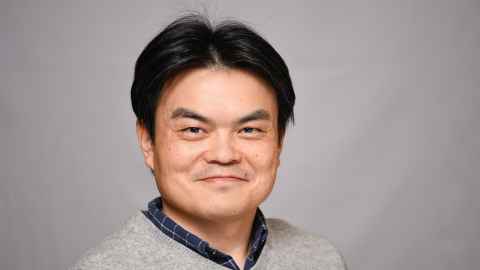Take 10 with... Nobuto Takeuchi
Dr Nobuto Takeuchi gives us 10 minutes of his time to discuss his research on the evolution of biological complexity using computational and mathematical modelling.

1. Describe your research topic to us in 10 words or less.
Understanding how biological complexity evolves, using computational and mathematical modelling.
2. Now explain it in everyday terms!
Biological systems are structured hierarchically. For example, a bee colony is a collective of many bees; an individual bee is a collective of many cells; and a cell is a collective of many molecules. This hierarchical structure is at the basis of biological complexity; obviously, a collective is more complex than its parts.
Here is something intriguing: cells, bees, and bee colonies all share one thing in common -that is, a division of labour. For example, cells display a division of labour between genome molecules and enzyme molecules; the bodies of bees display a division of labour between germ cells and soma cells; and bee colonies display a division of labour between queen bees and worker bees.
Genomes, germ cells, and queen bees transmit genetic information across generations, whereas enzymes, soma cells, and worker bees utilise this information. These divisions of labour are strikingly similar to each other, and the repeated pattern demands a scientific explanation. Our research group is building a unified theory that can explain this pattern, using computer simulations and mathematical modelling.
3. Describe some of your day-to-day research activities.
My day-to-day research activities include writing computer programs, plotting data, doing mathematical calculations, discussing research with colleagues and students, writing scientific articles, and writing grant proposals.
4. What do you enjoy most about your research?
I enjoy understanding the outcomes of models that are initially puzzling. I also enjoy discussions with other researchers and students.
5. Tell us something that has surprised or amused you in the course of your research.
When I was an undergraduate student around 2000, Professor Yasuji Sawada, then at Tohoku University in Japan, told me that one should do research about a subject that people do not even know how to research. I thought it was a good dictum, but didn’t know how to follow it.
Recently, Professor Kunihiko Kaneko and I developed a theory that can explain the central dogma of molecular biology as a general consequence of evolution. Before developing this theory, I, and possibly many others, did not know how to do research about the evolution of the central dogma. It surprises me that I somehow managed to follow - at least nearly - Professor Sawada’s dictum. I do not know how I did that, although I want to do it again.
6. How have you approached any challenges you’ve faced in your research?
When I was a graduate student, I was working in a building that had a corridor surrounding elevators in the middle, so I could walk the corridor in an infinite loop. When I got a challenging question, I set myself in an infinite loop of walking and thinking until I got a good answer. I still sometimes do that, but I have not found a better corridor since I left that building.
7. What questions have emerged as a result?
In biology, there are two kinds of dynamics: replicator dynamics and regulatory dynamics. Replicator dynamics refers to the dynamics of populations: populations of cells, plants, animals, viruses, etc. It is about a process involving competition, cooperation, cheating, predation etc. Regulatory dynamics, by contrast, refers to the dynamics of information processing, such as gene regulation, signal transduction, cell-cell communications and neural signal processing, all of which are about the transducing, processing and storing of information.
Evolution can transform population dynamics into regulatory dynamics. For example, the origin of multicellular organisms means that a population of competing cells evolves into an integrated collective of cooperating cells, where evolution transforms the population dynamics of cells into the regulatory dynamics of development. How does this transformation occur through evolution? This is a question that has occurred to me as a result of my research.
8. What kind of impact do you hope your research will have?
Shooting for the stars, I hope my research outcomes will be included in undergraduate textbooks.
9. If you collaborate across the faculty or University, or even outside the University, who do you work with and how does it benefit your research?
I am currently working on specific research projects and/or grant applications with the following people: Dr Austen Ganley; Professor Ant Poole; Dr Matthew Fullmer; Professor Kunihiko Kaneko at the University of Tokyo in Japan; Mr Bram van Dijk at Utrecht University in the Netherlands; and Professor Tim Cooper at Massey University.
I am continually in discussion with other people to seek collaboration or to simply gain new insights, which is a form of collaboration. Through this, I achieve what I cannot achieve alone.
10. What one piece of advice would you give your younger, less experienced research self?
This is not my own piece, but a piece I got from a paper by George A. Bartholomew (1982 American Zoologist 22:227-235): 'It is only a slight exaggeration to say that a biologist who aspires to be creative or innovative is probably wasting his time if he knows precisely what he is doing, or if he is intellectually comfortable at his work'. In a 2020 version, it’s better to replace 'he' with 'they' though.